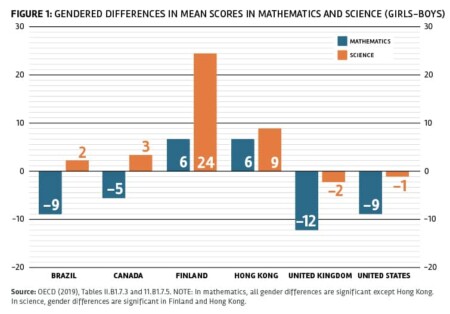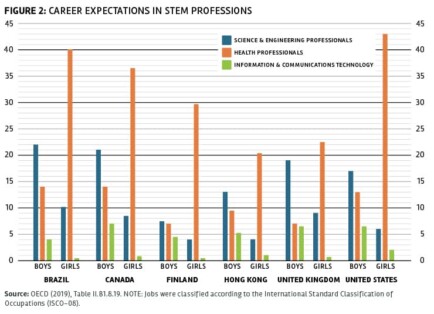One metric of interest to those involved in STEM equity research is the gender differences in mathematics and science performance. Research has shown that the gender gap in achievement in these subjects has narrowed significantly over the years in the United States (Hill, Corbett, and St. Rose 2010). The most recent PISA results, from 2018, show a small, yet significant, gender difference in mathematics performance for U.S. students. These are similar to the differences seen in Brazil and the United Kingdom. Finland and China, however, see the opposite, with girls outperforming boys in those countries. In science, the average gender gap is small, with girls outperforming boys in a number of countries. Figure 1 shows the gender differences in mean PISA scores in mathematics and science (girls–boys) among select countries.

In considering the factors that influence girls’ decisions to pursue STEM careers, math and science achievement and confidence are important. Even among students with similar performance results, however, a smaller proportion of girls than boys indicate interest in pursuing certain STEM careers — specifically, careers in engineering and technology. The PISA 2018 results show that girls express more interest than boys in pursuing careers in the health professions. Figure 2 presents select countries from the PISA 2018 report, illustrating the differences in career aspirations across multiple countries, by both gender and geographic region.

PISA 2018 results indicate that girls’ interest in pursuing non-health-related careers in STEM is low across OECD countries, with an average of only 7% of girls reporting that they want to work in a science and engineering profession and 1% of girls reporting that they want to work in a technology profession. While small differences in mathematics and science performance exist, these alone cannot explain the large differences observed in STEM career expectations. Societal norms and gender stereotypes also influence students’ career expectations and aspirations around the globe (OECD, 2019). Countering these norms and stereotypes by serving as role models, teachers, and mentors is one way women engineers and technologists can encourage more girls to have confidence in their abilities and pursue engineering and technology careers.
References
Hill, C., C. Corbett, and A. St. Rose (2010). Why So Few? Women in Science, Technology, Engineering, and Mathematics, AAUW.
OECD (2019). PISA 2018 Results (Volume II): Where All Students Can Succeed, PISA, OECD Publishing, Paris, https://doi.org/10.1787/b5fd1b8f-en.
Author
-

Roberta Rincon oversees SWE's research activities on gender equity issues affecting girls and women in engineering, from school to career.







